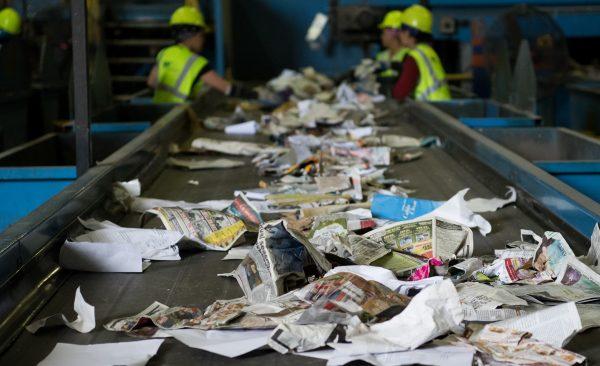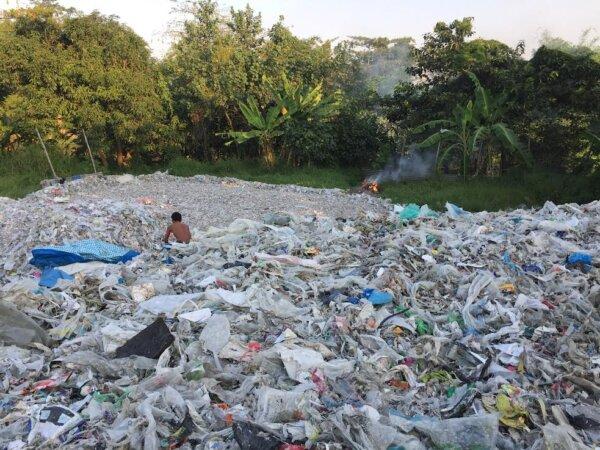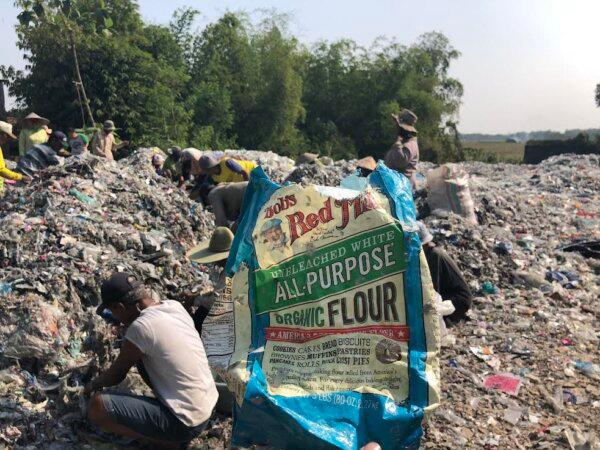Consumers have been misled about the recyclability of plastic. ‘It’s essentially state-mandated public deception,’ according to policy analyst David Allaway.

Bales of recycling material are prepared at the Waste Management Material Recovery Facility in Elkridge, Md., on June 28, 2018. (Saul Loeb/AFP/Getty Images)

Consumers have been misled about the recyclability of plastic, according to those who argue that industry labeling has caused the public to place too much trust in what is not an easy solution for reducing waste.
David Allaway is a senior policy analyst with the Oregon state’s Department of Environmental Quality (ODEQ).
He explained to The Epoch Times that the narrative surrounding plastic recycling was largely a public relations tactic to garner approval at a time in the late 1980s when it was becoming more frowned upon because of the mounting waste generated by its use.
In 1989, when the Minneapolis City Council passed an ordinance that banned most plastic packaging in grocery stores and fast food restaurants, other local governments in St. Paul, Minnesota, and Long Island, New York, were passing similar city regulations.
In 1988, the Society of the Plastics Industry (SPI), now the Plastics Industry Association, came up with a campaign “purportedly to help the public and recyclers sort different plastic resins apart from each other,” he said.
Plastic was labeled with a resin identification code (RIC), a numerical series of symbols inside a triangle of chasing arrows. This code identifies the type of plastic used in the packaging, with some types, such as polyethylene terephthalate, or PET #1, and high-density polyethylene, or HDPE # 2, being more recyclable than others.
“But the actual effect of the code has been to long mislead a lot of people into thinking that if the plastic has the chasing arrows on it, it can go in the recycling cart and will be recycled,” Mr. Allaway said.
The SPI successfully lobbied states to require consumer brands like Coca-Cola to put RIC on plastic packaging.
“Then it gets more complicated,” he said.
In 2008, the SPI handed those codes over to the American Society for Testing and Materials (ASTM), the international standards organization, which updated the recycle marking symbol.
According to the ASTM, the new marking symbols use a “solid equilateral triangle around the number” which “helps bring focus back to the system’s core mission: resin identification and quality control prior to recycling.”
The change from chasing arrows to one solid contiguous triangle, however, has led to confusion among states over what symbol to use in manufacturing and recycling.
According to the ODEQ, 36 states require the chasing-arrow RIC codes on plastics.
In recent years, Washington, Oregon, and California removed that requirement because of the confusion, while states like Oregon and Maine have passed legislation to put the responsibility for funding or ensuring responsible recycling on the manufacturer.
“Then you have 30-something other states saying you have to use the resin codes with the chasing arrows, so there are different state requirements,” he said.

Workers sort through recycling material at the Waste Management Material Recovery Facility in Elkridge, Md., on June 28, 2018. (Saul Loeb/AFP/Getty Images)
‘State-Mandated Public Deception’
What this has all amounted to is a confusion over what is recycled, and what is not, Mr. Allaway said.
“Most materials with the resin identification codes are not recyclable, and they aren’t accepted by local recyclable programs,” he said. “When you put them in the recycling bin, you’re basically playing roulette because curbside recycling programs differ throughout the country in what they accept.”
The unrecyclable plastic tossed into the recycling bin becomes more expensive to sort out at recycling facilities while continuing to add to the plastic waste, he said.
“The code has done much more harm than good,” he said. “The recycling industry has been warning the plastics industry since the 1990s but it’s done nothing about it because it’s to their financial benefit that the public continues to believe that all of these plastics can be recycled.”
According to the ASTM, the SPI developed the RIC “at the urging of recyclers during the 1980s.” However, Mr. Allaway said that wording is a way for the plastic industry “to pass the blame.”
The plastic industry claims the recycling industry called for the codes now mandated in over 30 states, yet the problem of plastic waste ultimately remains unsolved, he said.
“It’s essentially state-mandated public deception,” he said of the SPI’s RIC codes.
Federal Investment in Waste Management
Nena Shaw, the director of the resource and conservation and sustainability division of the Environmental Protection Agency (EPA) told The Epoch Times that environmental law, which goes back to the 1970s, is evolving to address these problems, which includes clearing up the confusion created by previous policies.
In December 2020, U.S. Sens. Sheldon Whitehouse (D-R.I.), Dan Sullivan (R-Alaska), and Bob Menendez (D-N.J.) passed the bipartisan Save Our Seas 2.0 Act that sets up a research foundation and looks at international and domestic policies to decrease ocean waste.
By 2050, the study said plastic production will have increased exponentially, generating 26,000 million metric tons, half of which will become waste as up to 23 million metric tons enter the ocean annually.
The Biden administration’s Bipartisan Infrastructure Bill earmarked $275 million for waste management improvement, which Ms. Shaw called “the largest investment that we’ve made as a nation in this area.”
“Last year, we announced that every state, territory, and the District of Columbia received funding to research and implement improvements to solid waste management capability and capacity,” she said. “In addition to that, we gave out 25 community grants, 59 tribal grants, and then 25 recycling education and outreach grants, so that’s the first step in dispersing money across the country to provide improvements to infrastructure as well as education to help resolve some of these challenges. But it’s just a start.”
She said plastic’s waste stream has become more and more complex over time because of a lack of investment in recycling technology.
“We do have challenges around how much is actually recyclable,” she said.
In 2021, the EPA implemented The National Recycling Strategy: Part One of a Series on Building a Circular Economy (NRS) to improve the nation’s solid waste recycling system, Ms. Shaw said.
“We recognized, given the fact that China stopped taking our plastic in 2018 under its National Sword policy that we needed to rethink how we dealt with solid waste in the United States,” Ms. Shaw said.
Under Operation National Sword, China placed more scrutiny on recyclable waste imported from other countries. However, the policy became a sobering reminder for those in the recycling industry like Zoe Heller, the deputy director of CalRecycle’s division of the circular economy, who told The Financial Times in 2019 that it “challenges us to admit that recycling isn’t free.”
“What this is really bringing up for California, the US and the rest of the world is that there has to be a paradigm shift in how we think about recycling globally,” Ms. Heller said.
It’s an interesting time as plastic production is only increasing and more people are becoming aware of what Ms. Shaw called a very tangible issue in that they have to make decisions every day on what they put in the trash and what they put in the recyclable bin, Ms. Shaw said.
On April 23 through 29, the United Nations will be hosting its fourth Intergovernmental Negotiating Committee on Plastics Pollution (INCPP) in Ottawa, Canada, where stakeholders will confer on global solutions, she said.
“It’s great to have the dialogue because it’s a recognition of the first step in overcoming a problem,” Ms. Shaw said.

Photos of East Java plastic pollution taken during the making of the Peak Plastic Foundation’s documentary, ‘The Story of Plastic,’ in 2017 and 2018. (Courtesy of Megan Ponder).
Improvements in Waste Export
Despite the concerns, the plastic recycling dilemma has improved, according to Mr. Allaway. “Back in 2012, about 36 percent of the plastics collected for recycling in this country were being shipped overseas with about 60 to 61 percent staying in North America,” he said. “As of 2021, only 8 percent of the material is going overseas, and 92 percent is staying in North America.”
Recycling in the United States is processed through commingle, or single-stream recycling in which all plastic, paper, and metals are collected in a single truck so that citizens don’t have to sort it out themselves.
It’s then sorted at a material recovery facility (MRF), where workers “unscramble the scrambled egg.”
“In that process, some of the plastics that can’t be marketed will go off to the landfill,” he said.
For example, plastics with the RIC code number seven or three are sent to the landfill, Mr. Allaway explained.
According to the American Chemistry Council’s chart on RIC codes, examples of products with code seven are “three and five-gallon water bottles, citrus juice and catsup bottles,” as well as “oven-baking bags, barrier layers, and custom packaging.”
Products with the RIC code three have “rigid packaging applications” made of polyvinyl chloride.
Other remaining plastics that aren’t sent to the landfill will go to a plastics reclaimer company that sorts, washes, and grinds the plastics into pellets or flakes which are then used to make other products, Mr. Allaway said.
And that’s part of the good news, the 92 percent of plastic staying in North America is going to the MRFs, he said, but they don’t do a perfect job.
“Some of the plastic ends up leaving the MRFs mixed up with the bales of paper that go to paper mills where the plastic is removed and tossed into a landfill,” he said.
Bales are sent to mills both in the United States and overseas, such as in East Java, Indonesia, where a paper mill purchases bales from North America. The mill screens out the plastics, which are then scattered across the countryside, polluting the streams and food supply of local villages.
“So, the recycling process in this country has become a pathway by which plastics are being dumped in other parts of the world,” he said. “It’s an ongoing problem.”

Photos of East Java plastic pollution taken during the making of the Peak Plastic Foundation’s documentary, ‘The Story of Plastic,’ in 2017 and 2018. (Courtesy of Megan Ponder).
‘Waste Export to Indonesia Must be Stopped’
In East Java, Prigi Arisandi, an Indonesian biologist and environmentalist, faces this ongoing problem every day.
He founded Ecoton to bring awareness to plastic pollution in Indonesia and to expose the industries and governments discarding their plastic waste in the region.
Mr. Arisandi, who will be attending the INCPP at the end of the month, told The Epoch Times that developed countries like the United States, Japan, and China, send “massive amounts of plastic waste to Indonesia” despite their inability to recycle it.
Heavy metals and other chemical compounds such as Bisphenol A, or BPA, and phthalates have been found in the fish, air, and in a river sourced for drinking water by 4 million people in Sidoarjo and Surabaya City.
“We found that burning imported plastic waste produces dioxin and furan compounds which contaminate chicken eggs,” Mr. Arisandi said.
Plastic pollution, including dumping into rivers and burning of materials, has contributed to an increase in cancer rates among residents along the riverbanks, particularly in children, he reported.
“Recycling imported waste has polluted rivers in Indonesia with microplastics and EDCs [endocrine disruptors], poisoned the air, and poisoned our food chain with furan compounds and dioxin,” he said. “Waste exports to Indonesia must be stopped.”

Photos of East Java plastic pollution taken during the making of the Peak Plastic Foundation’s documentary, ‘The Story of Plastic,’ in 2017 and 2018. (Courtesy of Megan Ponder).
‘Complicated System’
In response to an initial question on where the plastic waste goes, Mr. Allaway answered, “It goes all over the place. It’s a complicated system.”
Efforts are being made to simplify this system and reduce plastic waste, efforts that Ms. Shaw said 85 percent of Americans support.
“I say that because it’s important to recognize that people want to do the right thing,” she said.